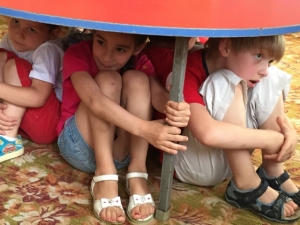Disaster Risk Reduction
While many Tbilisians and Akhaldabans dealt with the reality of the recent landslide and flood close-at-hand, I was forced to watch the events happen via social media from a seminar in Batumi. I, like many of my colleagues there, worried about family and friends and spent the best part of Sunday with one ear, one eye and most fingers on my mobile as I checked regularly on my kids and husband and also organized journalists to keep you, Dear Readers, up-to-date with the latest news.
My other ear and eye were very appropriately placed, as the theme of the one-day seminar, run by the Arbeiter Samariter Bund (ASB) in Georgia was Disaster Risk Reduction (DRR).
The DRR training was, this time, for awareness-raising amongst media representatives from Georgian television, radio and print media. However, the usual training is focused on the younger generation with ASB currently having provided training and training materials (flashcards, speakerphones, hardhats and other equipment) to 344 kindergartens in four regions of Georgia at high-risk from natural disasters (Svaneti-Samegrelo, Adjara, Samtshke-Javaheti and Tbilisi). One of these kindergartens is Khobi Kindergarten No.2, to which my colleagues and I were taken to watch the well-trained children show us how they would react during an earthquake, one of a number of natural disaster types that can befall Georgia throughout the typical year.
According to statistical analysis of 2005-2012, on average:
· 20-25 cases of flooding are registered each year in Georgia.
· A serious storm happens 5-8 times a year.
· 15-20 cases of landslides are registered annually.
There are 50,000 landslide-prone areas identified in Georgia. The danger zones include up to 2000 settled locations with more than 200,000 dwellers. The total area of land damaged by landslides exceeds 1.5 million hectares.
Teona Julukhadze, ASB Disaster Risk Reduction Program Coordinator: We set up this project in May 2014 and the first phase is due to end in December this year. Our project is principally focused on kindergarten readiness in the face of natural disasters. We give trainings in first aid and DRR to care-givers and teachers who then adapt the materials and pass the knowledge on to the children. We created flashcards to guide them. As part of the project in each kindergarten we created committees who will ensure the safety of the kindergartens after the ASB project finishes. We ran this weekend’s one day seminar on DRR, and got the children of Khobi kindergarten to demonstrate an earthquake and fire simulation, in order to increase the spread of awareness through the media representatives who attended.
Children learn best through play, and the kindergarten teachers seemed to have this idea clearly in their minds. Using ASB flashcards and other material as the basis of their teaching, they are free to adapt to suit the purpose- with games, songs and puppets.
Nargiza Tugushi, Director of the Number Two Kindergarten of Khobi: I am very satisfied with the training. The children have learnt it well, thanks to ASB and the work of the care-givers here. It is highly necessary and important knowledge which they will carry for the rest of their lives.
QUICK DRR FACTS - WHAT YOU NEED TO KNOW
Landslide
Rule #1- Get away fast! Run on foot at a right angle to the oncoming flow (do not stay in its path trying to outrun it- you most likely won’t be able to)!
Avalanche
Rule #1- Get down! If you’re in a building, get in a corner, up-end a table in front of you, crouch down, cover your head and be ready for the impact. If you’re in the open, turn your back to the on-coming snow and curl into an embryo position. Let the avalanche roll you. If you then find yourself buried and don’t know which way is up, spit. The water will fall thanks to gravity and you’ll know which way to start digging your way out!
Flood
Rule #1- Get out, get high! If you get an advance flood warning, turn off the electrics and gas and move as much as you can (TVs, rugs, valuables) onto upper floors. Put sandbags in front of your house to limit or prevent water impact. If you have no warning, forget the valuables, get on the roof and call the emergency services (112), then wait.
Fire
Rule #1- Get down, wait for the emergency services (112)! There’s more oxygen close to the floor so if the room is filling with smoke, get down on your hands and knees. If you can cover your mouth and nose with a damp cloth, even better. If the fire is outside the door, do not open the door. Try to fill the space under the door with (damp) cloth to limit the smoke coming in. Go to the window and, if you know the emergency services (112) are coming, wait. Do not open the window unless you are uncertain whether the emergency services (112) are coming as the in-rush of air can cause the fire to increase. If you are higher up than the third floor, you should not try to jump. If you have no other choice and are three floors up or lower, tie cloth together to make a rope and try to get out safely however you can- this should be your last option, however!
Earthquake
Rule #1- Get undercover, cover your head! Typical earth tremors last mere seconds, which doesn’t leave much time to react. Most of the people at the seminar with me followed their base instinct and ran for the door at the first simulated tremor. DO NOT RUN! If you are inside, get immediately under the nearest table or bed and cover your head- your head and spine should be under cover. Once the initial tremors have passed you may have a 6-7 minute window with which to move. If you know that outside your building is a big open space and you can make it there within this 6-7 minute timeframe, cover your head with your handbag or a cushion (or any other thick object) and walk quickly and calmly out of the building and move as far away from the building as possible. If not (such as when you are higher up than three floors), stay put under that table or bed until you are sure the earthquake risk has passed.
Emergency Bag
Rule #1- Keep it close! An emergency bag should typically contain:
· A first aid kit (ready prepared, such as those you can buy at a pharmacy in a small zip-case)
· Water (half a litre or more)
· Dry food, such as crackers (keep an eye on the expiry date and replace as necessary)
· Torch and batteries
· Whistle, for attracting attention more easily than shouting
· Rope
· Small portable radio and batteries- for keeping up-to-date on rescue operations
Singing with smiling, unafraid faces, the children of Khobi kindergarten No.2 showed their audience how they will handle the next earthquake: calmly and orderly and with every care not just for themselves, but for those around them. The message of their song as they descended into the playground with cushions held over their heads: Prevention, protection, and help each other! It was an example to us all.
Katie Ruth Davies












